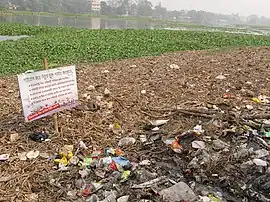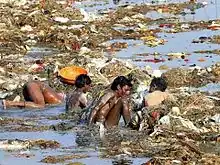Water pollution in India
.jpg.webp)

Water pollution sewage.[1] Other sources of pollution include agricultural runoff and unregulated small-scale industry. Most rivers, lakes and surface water in India are polluted due to industries, untreated sewage and solid wastes.[2][3]
The issues
Untreated Sewage
There is a large gap between generation and treatment of domestic waste water in India. The problem is not only that India lacks sufficient treatment capacity but also that the sewage treatment plants that exist do not operate and are not maintained.[4]
The majority of the government-owned sewage treatment plants remain closed most of the time due to improper design or poor maintenance or lack of reliable electricity supply to operate the plants, together with absentee employees and poor management. The waste water generated in these areas normally percolates into the soil or evaporates. The uncollected waste accumulates in the urban areas causing unhygienic conditions and releasing pollutants that leach into surface and groundwater.[5]

Sewage discharged from cities, towns and some villages is the predominant cause of water pollution in India.[1] Investment is needed to bridge the gap between the sewage India generates and its treatment capacity of sewage per day.[6] Major cities of India produce 38,354 million litres per day (MLD) of sewage, but the urban sewage treatment capacity is only 11,786 MLD.[7] A large number of Indian rivers are severely polluted as a result of discharge of domestic sewage.
The Central Pollution Control Board, a Ministry of Environment & Forests Government of India entity, has established a National Water Quality Monitoring Network comprising 1,429 monitoring stations in 28 states and 6 in Union Territories on various rivers and water bodies across the country. This effort monitors water quality year round. The monitoring network covers 293 rivers, 94 lakes, 9 tanks, 41 ponds, 8 creeks, 23 canals, 18 drains and 411 wells distributed across India.[3] Water samples are routinely analysed for 28 parameters including dissolved oxygen, bacteriological and other internationally established parameters for water quality. Additionally 9 trace metals[8] parameters and 28 pesticide residues are analysed. Biomonitoring is also carried out on specific locations.
The scientific analysis of water samples from 1995 to 2008 indicates that the organic and bacterial contamination is severe in water bodies of India. This is mainly due to discharge of domestic waste water in untreated form, mostly from the urban centres of India.
Organic matter
In 2010 the water quality monitoring found almost all rivers with high levels of BOD (a measure of pollution with organic matter). The worst pollution, in decreasing order, were found in river Markanda (490 mg/l BOD), followed by river Kali (364), river Amlakhadi (353), Yamuna canal (247), river Yamuna at Delhi (70) and river Betwa (58). For context, a water sample with a 5-day BOD between 1 and 2 mg O/L indicates a very clean water, 3 to 8 mg O/L indicates a moderately clean water, 8 to 20 indicates borderline water, and greater than 20 mg O/L indicates ecologically unsafe, polluted water.
The levels of BOD are severe near the cities and major towns. In rural parts of India, the river BOD levels were sufficient to support aquatic life.[1][7]
Coliform levels
Rivers Yamuna, Ganga, Gomti, Ghaghara, Chambal, Mahi, Vardha and Godavari, are amongst the other most coliform polluted water bodies in India. For context, coliform must be below 104 MPN/100 ml,[9] preferably absent from water for it to be considered safe for general human use, and for irrigation where coliform may cause disease outbreak from contaminated-water in agriculture.[10][11]
In 2006, 47 percent of water quality monitoring reported coliform concentrations above 500 MPN/100 ml. During 2008, 33 percent of all water quality monitoring stations reported a total coliform levels exceeding those levels, suggesting recent effort to add pollution control infrastructure and upgrade treatment plants in India, may be reversing the water pollution trend.[3]
Treatment of domestic sewage and subsequent utilization of treated sewage for irrigation can prevent pollution of water bodies, reduce the demand for fresh water in the irrigation sector and become a resource for irrigation. Since 2005, Indian wastewater treatment plant market has been growing annually at the rate of 10 to 12 percent. The United States is the largest supplier of treatment equipment and supplies to India, with 40 percent market share of new installation.[12] At that rate of expansion, and assuming the government of India continues on its path of reform, major investments in sewage treatment plants and electricity infrastructure development, it was estimated India will nearly triple its water treatment capacity by 2015, and treatment capacity supply will match India's daily sewage water treatment requirements by about 2020.
The Solution
Water conservation in India is gaining pace. The Ganga rejuvenation efforts by the union government, the Yamuna clean-up are some of the government initiated efforts.[13] The Chennai River Restoration trust's efforts to clean the Cooum, Adyar rivers in Chennai and civil society efforts spearheaded by organizations like Environmentalist Foundation of India (E.F.I) to clean lakes and ponds in the country are seen as significant development towards water conservation.[14]
Other problems
A joint study by PRIMER and the Punjab Pollution Control Board in 2008, revealed that in villages along the Nullah, fluoride, mercury, beta-endosulphan and heptachlor pesticide were more than permissible limit (MPL) in ground and tap water. Plus the water had high concentration of COD and BOD (chemical and biochemical oxygen demand), ammonia, phosphate, chloride, chromium, arsenic and chlorpyrifos pesticide. The ground water also contains nickel and selenium, while the tap water has high concentration of lead, nickel and cadmium.[15]
Flooding during monsoons worsens India's water pollution problem, as it washes and moves solid waste and contaminated soils into its rivers and wetlands. The annual average precipitation in India is about 4000 billion cubic metres.[6] From this, with the state of Indian infrastructure in 2005, the available water resource through the rivers is about 1869 billion cubic meters. Accounting to uneven distribution of rain over the country each year, water resources available for utilization, including ground water, is claimed to be about 1122 billion cubic meters. Much of this water is unsafe, because pollution degrades water quality. Water pollution severely limits the amount of water available to Indian consumers, its industry and its agriculture.
Specific rivers
The Ganges

More than 500 million people live along the [Ganges] River.[16][17] An estimated 2,000,000 persons ritually bath daily in the river, which is considered holy by Hindus.[18] Ganges river pollution is a major health risk.[19]
NRGBA was established by the Central Government of India, on 20 February 2009 under Section 3(3) of the Environment Protection Act, 1986. It also declared Ganges as the "National River" of India.[20] The chair includes the Prime Minister of India and Chief ministers of states through which the Ganges flows.[21]
The Yamuna

By an estimate by 2012, Delhi's sacred Yamuna river contained 7,500 coliform bacteria per 100cc of water. A number of NGOs, pressure groups, eco-clubs, as well as citizens' movements, have been active in their task to clean the river.[22]
Even though India revised its National Water Policy in 2002 to encourage community participation and decentralize water management, the country's complex bureaucracy ensures that it remains a "mere statement of intent." Responsibility for managing water issues is fragmented among a dozen different ministries and departments without any coordination. The government bureaucracy and state-run project department has failed to solve the problem, despite having spent many years and $140 million on this project.[22]
Other
- Buddha Nullah, a seasonal water stream, which runs through the Malwa region
- The Mithi River, which flows through the city of Mumbai, is heavily polluted.[23]
- Mithi River pollution
- Mula River pollution
- Gomti River pollution
- Vrishabhavathi River pollution
See also
- Alkali soil
- Environmental impact of irrigation
- Environmental issues in India
- Indian states and union territories ranked by prevalence of open defecation
- Ground water in India
- Interstate River Water Disputes Act
- Irrigation in India
- National Water Policy
- Water resources in India
- Water scarcity in India
- Water supply and sanitation in India
- Yamuna Mission
References
- 1 2 3 "Evaluation Of Operation And Maintenance Of Sewage Treatment Plants In India-2007" (PDF). Central Pollution Control Board, Ministry of Environment & Forests. 2008.
- ↑ "Water Quality Database of Indian rivers, MoEF". Retrieved 15 September 2016.
- 1 2 3 "Central Pollution Control Board, India, Annual Report 2008–2009" (PDF). Central Pollution Control Board, Ministry of Environment & Forests, Govt of India. 2009.
- ↑ %5b%5bFile:Sahil|4.5 6.2px|thumb|alt=sahil|sahil%5d%5d te "How India's cities came to drown in sewage and waste". The Guardian. 1 August 2012. Retrieved 17 December 2019.
{{cite web}}: Check|url=value (help) - ↑ "A Brief Overview of Groundwater Pollution in India". 2021-04-24. Retrieved 2021-05-18.
- 1 2 "Status of Sewage Treatment in India" (PDF). Central Pollution Control Board, Ministry of Environment & Forests, Govt of India. 2005.
- 1 2 Kaur et al., Wastewater production, treatment and use in India UN Water (Publisher)
- ↑ Koshy, Jacob (2019-12-11). "Heavy metals contaminating India's rivers". The Hindu. ISSN 0971-751X. Retrieved 2019-12-13.
- ↑ Ceri Morris; et al. (May 2008). "Comparison of Transcription-Mediated Amplification and Growth-Based Methods for the Quantitation of Enterococcus Bacteria in Environmental Waters". Applied and Environmental Microbiology. 74 (10): 3319–3320. Bibcode:2008ApEnM..74.3319M. doi:10.1128/AEM.02623-07. PMC 2394953. PMID 18378648.
- ↑ Annette Prüss; et al. (May 2002). "Estimating the Burden of Disease from Water, Sanitation, and Hygiene at a Global Level" (PDF). Environmental Health Perspectives. 110 (5): 537–542. doi:10.1289/ehp.02110537. PMC 1240845. PMID 12003760.
- ↑ "Guidelines for Drinking-water Quality, 4th Edition" (PDF). World Health Organization. 2011.
- ↑ "Indian Water and Wastewater Treatment Market Opportunities for US Companies" (PDF). Virtus Global Partners. 2008.
- ↑ http://mowr.gov.in/schemes-projects-programmes/programmes/ganga-rejuvenation
- ↑ "This Organisation Has Restored 39 Lakes in 10 Years. This Year, You Can Help Them Fight Drought!". 6 May 2017.
- ↑ "Buddha Nullah the toxic vein of Malwa". Indian Express. May 21, 2008.
- ↑ Ganga conservation efforts inspire thousands
- ↑ A Sacred River Endangered by Global Warming 17 June 2007
- ↑ Hyde, Natalie (2010). Population patterns : what factors determine the location and growth of human settlements?. New York: Crabtree Pub. p. 15. ISBN 978-0-7787-5182-3.
- ↑ India's polluted Ganges River threatens people's livelihoods DW Germany (2013)
- ↑ "National Ganga River Basin Authority"
- ↑ "Composition of NGRBA."
- 1 2 Yamuna: Story of a river being poisoned to death. The Hindu on July 6, 2012 issue
- ↑ Pravin U. Singare; Ravindra M. Mishra; Manisha P. Trivedi; Deepak V. Dagli (2012). "Aquatic pollution in Mithi River of Mumbai: assessment of physico-chemical parameters". Interdisciplinary Environmental Review. 13 (4): 245–268. doi:10.1504/ier.2012.051425.